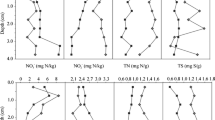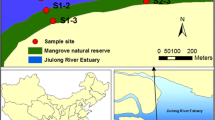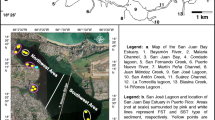Abstract
Denitrification in lake sediments removes nitrogen and releases N2O to the atmosphere, contributing to global warming. However, the rates and controls of sediment denitrification and N2O production are still poorly understood in lakes. In this study, we measured potential denitrification, unamended denitrification and N2O production rate in sediments which were collected from 68 sites in 20 Chinese plateau lakes of varying watershed land uses. The result showed that potential denitrification rate of human-dominated lakes (37.94 ± 8.91 ng N g−1 h−1) was significantly higher than that of reference lakes (18.50 ± 3.22 ng N g−1 h−1). In addition, potential denitrification rate was positively related to the proportion of human land uses in watersheds. At the lake level, unamended denitrification and N2O production rates were significantly related to water chemistry or sediment properties (e.g., conductivity and sediment total nitrogen). Water chemistry and sediment properties together accounted for 0–69 % of the variance in denitrification and N2O production rates. Variance partitioning showed that unamended denitrification and N2O production rates in human-dominated lakes were controlled primarily by sediment properties, while in reference lakes were generally controlled by water chemistry. Our findings suggest that Chinese plateau lakes can remove large quantities of nitrogen through sediment denitrification and produce small amounts of N2O. The relative contributions of water chemistry and sediment properties to the lake denitrification and N2O production vary widely.




Similar content being viewed by others

References
Abell JM, Özkundakci D, Hamilton DP (2010) Nitrogen and phosphorus limitation of phytoplankton growth in New Zealand lakes: implications for eutrophication control. Ecosystems 13:966–977
Beaulieu JJ, Tank JL, Hamilton SK, Wollheim WM, Hall RO Jr, Mulholland PJ, Peterson BJ, Ashkenas LR, Cooper LW, Dahm CN, Dodds WK, Grimm NB, Johnson SL, Mcdowell WH, Poole GC, Valett HM, Arango CP, Bernot MJ, Burgin AJ, Crenshaw CL, Helton AM, Johnson LT, O‘Brien JM, Potter JD, Sheibley RW, Sobota DJ, Thomas SM (2011) Nitrous oxide emission from denitrification in stream and river networks. Proc Natl Acad Sci USA 108:214–219
Bettez ND, Groffman PM (2012) Denitrification potential in stormwater control structures and natural riparian zones in an urban landscape. Environ Sci Technol 46:10909–10917
Boyer EW, Alexander RB, Parton WJ, Li C, Terbach-Bahl K, Donner SD, Skaggs RW, Del Gross SJ (2006) Modeling denitrification in terrestrial and aquatic ecosystems at regional scales. Ecol Appl 16:2123–2142
Bruesewitz DA, Hamilton DP, Schipper LA (2011) Denitrification potential in lake sediment increases across a gradient of catchment agriculture. Ecosystems 14:341–352
Bruesewitz DA, Tank JL, Hamilton SK (2012) Incorporating spatial variation of nitrification and denitrification rates into whole-lake nitrogen dynamics. J Geophys Res 117, G00N07. doi:10.1029/2012JG002006
Carpenter SR, Caraco NF, Correll DL, Howarth RW, Sharpley AN, Smith VH (1998) Nonpoint pollution of surface waters with phosphorus and nitrogen. Ecol Appl 8:559–568
Cheruvelil KS, Soranno PA, Bremigan MT, Wagner T, Martin SL (2008) Grouping lakes for water quality assessment and monitoring: the roles of regionalization and spatial scale. Environ Manag 41:425–440
Elser JJ, Kyle M, Steger L, Nydick KR, Baron JS (2009) Nutrient availability and phytoplankton nutrient limitation across a gradient of atmospheric nitrogen deposition. Ecology 90:3062–3073
Felber R, Conen F, Flechard CR, Neftel A (2012) Theoretical and practical limitations of the acetylene inhibition technique to determine total denitrification losses. Biogeosciences 9:4125–4138
Forshay KJ, Dodson SI (2011) Macrophyte presence is an indicator of enhanced denitrification and nitrification in sediments of a temperate restored agricultural stream. Hydrobiologia 668:21–34
Forshay KJ, Stanley EH (2005) Rapid nitrate loss and denitrification in a temperate river floodplain. Biogeochemistry 75:43–64
Freymond CV, Wenk CB, Frame CH, Lehmann MF (2013) Year-round N2O production by benthic NOx reduction in a monomictic south-alpine lake. Biogeosciences 10:8373–8383
GarcÍa-Ruiz R, Pattinson SN, Whitton BA (1998) Denitrification in river sediments: relationship between process rate and properties of water and sediment. Freshw Biol 39:467–476
Groffman PM, Altabet MA, Böhlke JK, Butterbach-Bahl K, David MB, Firestone MK, Giblin AE, Kana TM, Nielsen LP, Voytek MA (2006) Methods for measuring denitrification: diverse approaches to a difficult problem. Ecol Appl 16:2091–2122
Harrison JA, Maranger RJ, Alexander RB, Giblin AE, Jacinthe PA, Mayorga E, Seitzinger SP, Sobota DJ, Wollheim WM (2009) The regional and global significance of nitrogen removal in lakes and reservoirs. Biogeochemistry 93:143–157
Hayakawa A, Nakata M, Jiang R, Kuramochi K, Hatano R (2012) Spatial variation of denitrification potential of grassland, windbreak forest, and riparian forest soils in an agricultural catchment in eastern Hokkaido, Japan. Ecol Eng 47:92–100
Hefting MM, Bobbink R, Janssens MP (2006) Spatial variation in denitrification and N2O emission in relation to nitrate removal efficiency in a N-stressed riparian buffer zone. Ecosystems 9:550–563
Herlihy AT, Sobota JB, McDonnell TC, Sullivan TJ, Lehmann S, Tarquinio E (2013) An a priori process for selecting candidate reference lakes for a national survey. Freshw Sci 32:385–396
Inwood SE, Tank JL, Bernot MJ (2005) Patterns of denitrification associated with land use in 9 midwestern headwater streams. J N Am Benthol Soc 24:227–245
Inwood SE, Tank JL, Bernot MJ (2007) Factors controlling sediment denitrification in midwestern streams of varying land use. Microb Ecol 53:247–258
Kreiling RM, Richardson WB, Cavanaugh JC, Bartsch LA (2011) Summer nitrate uptake and denitrification in an upper Mississippi River backwater lake: the role of rooted aquatic vegetation. Biogeochemistry 104:309–324
Liu W, Zhang Q, Liu G (2010) Lake eutrophication associated with geographic location, lake morphology and climate in China. Hydrobiologia 644:289–299
Liu W, Zhang Q, Liu G (2011) Effects of watershed land use and lake morphometry on trophic state of Chinese lakes: implications for eutrophication control. Clean-Soil Air Water 39:35–42
Liu W, Li S, Bu H, Zhang Q, Liu G (2012) Eutrophication in the Yunnan Plateau lakes: the influence of lake morphology, watershed land use, and socio-economic factors. Environ Sci Pollut Res 19:858–870
Ma RH, Yang GH, Duan HT, Jiang JH, Wang SM, Feng XZ, Li AN, Kong FX, Xue B, Wu JL, Li SJ (2011) China’s lakes at present: number, area and spatial distribution. Sci China Earth Sci 54:283–289
Martin LA, Mulholland PJ, Webster JR, Valett HM (2001) Denitrification potential in sediments of headwater streams in the southern Appalachian Mountains, USA. J N Am Benthol Soc 20:505–519
Mathieu O, Hénault C, Lévêque J, Baujard E, Milloux MJ, Andreux F (2006) Quantifying the contribution of nitrification and denitrification to the nitrous oxide flux using 15N tracers. Environ Pollut 144:933–940
McCrackin ML, Elser JJ (2010) Atmospheric nitrogen deposition influences denitrification and nitrous oxide production in lakes. Ecology 91:529–539
Mengis M, Gachter R, Wehrli B (1997) Sources and sinks of nitrous oxide (N2O) in deep lakes. Biogeochemistry 38:281–301
Müller B, Lotter AF, Sturm M, Ammann A (1998) Influence of catchment quality and altitude on the water and sediment composition of 68 small lakes in central Europe. Aquat Sci 60:316–337
Pell M, Stenberg B, Stenström J, Torstensson L (1996) Potential denitrification activity assay in soil—With or without chloramphenicol? Soil Biol Biochem 28:393–398
Piña-Ochoa E, Álvarez-Cobelas M (2006) Denitrification in aquatic environments: a cross-system analysis. Biogeochemistry 81:111–130
Powers SM, Robertson DM, Stanley EH (2014) Effects of lakes and reservoirs on annual river nitrogen, phosphorus, and sediment export in agricultural and forested landscapes. Hydrol Process 28:5919–5937
Roy R, Legendre P, Knowles R, Charlton MN (1994) Denitrification and methane production in sediment of Hamilton Harbour (Canada). Microb Ecol 27:123–141
Saggar S, Jha N, Deslippe J, Bolan NS, Luo J, Giltrp DL, Kim DG, Zaman M, Tilman RW (2013) Denitrification and N2O:N2 production in temperate grasslands: processes, measurements, modelling and mitigating negative impacts. Sci Total Environ 465:173–195
Saunder DL, Kalff J (2001) Nitrogen retention in wetlands, lakes and rivers. Hydrobiologia 443:205–212
Seitzinger SP (1988) Denitrification in freshwater and coastal marine ecosystems: ecological and geochemical significance. Limnol Oceanogr 33:702–724
Seitzinger SP, Harrison JA, Böhlke JK, Bouwman AF, Lowrance R, Peterson B, Tobias C, Van Drecht G (2006) Denitrification across landscapes and waterscapes: a synthesis. Ecol Appl 16:2064–2090
Ussiri D, Lal R (2013) Soil emission of nitrous oxide and its mitigation. Springer, Dordrecht
Van Luijn F, Boers P, Lijklema L (1996) Comparison of denitrification rates in lake sediments obtained by the N2 flux method, the 15N isotope pairing technique and the mass balance approach. Water Res 30:893–900
Vitousek PM, Aber JD, Howarth RW, Likens GE, Matson PA, Schindler DW, Schlesinger WH, Tilman DG (1997) Human alteration of the global nitrogen cycle: sources and consequences. Ecol Appl 7:737–750
Wallenstein MD, Myrold D, Voytek M, Firestone M (2006) Environmental controls on denitrifying communities and denitrification rates: insights from molecular methods. Ecol Appl 16:2143–2152
Wang SM, Dou HS (1998) Chinese lake catalogue. Science Press, Beijing
Xing G (1998) N2O emission from cropland in China. Nutr Cycl Agroecosys 52:249–254
Yang X, Anderson NJ, Dong X, Shen J (2008) Surface sediment diatom assemblages and epilimnetic total phosphorus in large, shallow lakes of the Yangtze floodplain: their relationships and implications for assessing long-term eutrophication. Freshw Biol 53:1273–1290
Acknowledgments
The authors would like to thank Lu Yao, Haoping Wu, and Beibei Hao for their assistance with field sampling and laboratory analyses. Funding was provided by the Special S&T Project on Treatment and Control of Water Pollution (2013ZX07102–005) and the National Science Foundation of China (31270583 and 31370550).
Conflict of interest
The authors declare that there is no conflict of interest.
Author information
Authors and Affiliations
Corresponding author
Additional information
Responsible Editor: Jennifer Leah Tank.
Electronic supplementary material
Below is the link to the electronic supplementary material.
Rights and permissions
About this article
Cite this article
Liu, W., Wang, Z., Zhang, Q. et al. Sediment denitrification and nitrous oxide production in Chinese plateau lakes with varying watershed land uses. Biogeochemistry 123, 379–390 (2015). https://doi.org/10.1007/s10533-015-0072-9
Received:
Accepted:
Published:
Issue Date:
DOI: https://doi.org/10.1007/s10533-015-0072-9



